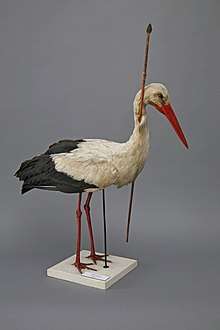Pfeilstorch

The term Pfeilstorch (German for "arrow stork") is given to storks injured by an arrow while wintering in Africa, before returning to Europe with the arrow stuck in their bodies. To date, around 25 Pfeilstörche have been documented.
The first and most famous Pfeilstorch was a white stork found in 1822 near the German village of Klütz, in the state of Mecklenburg-Vorpommern. It was carrying an arrow from central Africa in its neck. The specimen was stuffed and can be seen today in the zoological collection of the University of Rostock. It is therefore referred to as the Rostocker Pfeilstorch.[1][2][3]
This Pfeilstorch was crucial in understanding the migration of European birds. Before migration was understood, people had no other explanation for the sudden annual disappearance of birds like the white stork and barn swallow. Some theories of the time held that they turned into mice, or hibernated at the bottom of the sea during the winter, and such theories were even propagated by zoologists of the time.[4] The Rostocker Pfeilstorch in particular proved that birds migrate long distances to wintering grounds.[5]
References
- ↑ Zoologische Sammlung der Universität Rostock (in German) article with picture of the Rostocker Pfeilstorch
- ↑ Flyer for the Rostock University Zoological Collection (in English)
- ↑ Der Sproessling 3 Archived 2014-11-25 at the Wayback Machine. (in German) edition of the local student association's magazine containing an article about the Pfeilstorch
- ↑ Cocker, Mark; Mabey, Richard (2005). Birds Britannica. Chatto & Windus. p. 315. ISBN 0-7011-6907-9.
- ↑ Ragnar K. Kinzelbach: Das Buch vom Pfeilstorch, Basilisken-Presse 2005, ISBN 3-925347-78-X (in German)
Further reading
(in German) Hagen, H. (1975). "Beobachtung eines Pfeilstorches in Ost-Afrika [White Stork (Ciconia ciconia) with arrow protruding from its body seen in East Africa]." Ornithologische Mitteilungen. 27(5): 111-112.